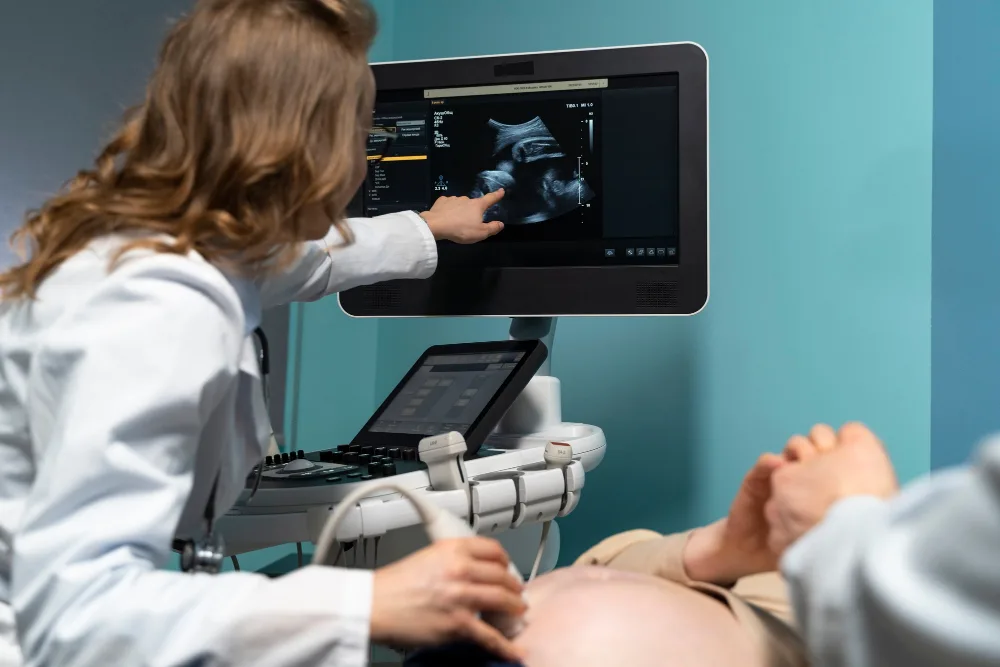When the unexpected happens, knowing you’re not alone can make all the difference. This guide offers essential support and information for women experiencing pregnancy loss.
Introduction: When Dreams Take an Unexpected Turn
I remember staring at the bathroom floor, watching as my hopes for motherhood seemed to wash away with each drop of blood. If you’re reading this because you’re going through something similar, please know this first: you are not alone. Pregnancy loss affects millions of women each year, yet somehow, we still struggle to talk about it openly.
Miscarriage—the unexpected end of a pregnancy before the 20th week—touches so many lives but remains shrouded in silence and misconceptions. Today, I want to break that silence and provide you with essential information, comfort, and practical guidance for navigating this difficult journey.
1. What Is a Miscarriage? Understanding the Basics
A miscarriage, medically known as spontaneous abortion, is the natural loss of a pregnancy before the 20th week. Most miscarriages happen during the first trimester (the first 13 weeks of pregnancy).
What’s actually happening in your body: During a miscarriage, the embryo or fetus and the surrounding tissue separate from the uterine wall and pass out of the body. Sometimes this happens quickly; other times, it can take days or even weeks.
2. Recognizing the Warning Signs: Common Miscarriage Symptoms
When I first noticed spotting during my pregnancy, I tried to convince myself it was normal. Many pregnant women do experience some light bleeding, but it’s always worth mentioning to your healthcare provider. Here are the symptoms that may indicate a miscarriage:
- Vaginal bleeding: This can range from light spotting to heavy bleeding, often with clots
- Cramping and pain: May feel similar to menstrual cramps, but can be more intense
- Back pain: Persistent lower back pain that feels different than usual pregnancy discomfort
- Passing tissue: You might notice tissue with clots passing from your vagina
- Decreasing pregnancy symptoms: A sudden decrease in symptoms like morning sickness or breast tenderness
- Fluid or discharge: Passing clear or pink vaginal fluid
When to seek immediate medical attention: If you experience severe pain, heavy bleeding (soaking through more than one pad an hour), dizziness, fever, or chills, please seek emergency care right away.

3. The Many Causes of Miscarriage: What We Know (and Don’t Know)
Perhaps the most difficult question after a miscarriage is “why?” While doctors can identify certain risk factors, in many cases, the exact cause remains unknown. This can be incredibly frustrating, but it’s important to remember: most miscarriages are not caused by anything the mother did or didn’t do.
Common causes of miscarriage include:
Chromosomal abnormalities: About 50-60% of first-trimester miscarriages are caused by chromosomal issues that occur by chance during embryo development.
Maternal health conditions: Certain medical conditions can increase the risk, including:
- Uncontrolled diabetes
- Thyroid disease
- Severe high blood pressure
- Autoimmune disorders like antiphospholipid syndrome
- Certain infections
Uterine or cervical problems: Structural issues with the uterus or cervix can sometimes lead to pregnancy loss.
Advanced maternal age: The risk of miscarriage increases with age, particularly after 35.
Lifestyle factors: Some behaviors are associated with increased risk:
- Smoking
- Excessive alcohol consumption
- Drug use
- Exposure to certain environmental toxins
4. How Common Is Miscarriage? Breaking the Silence
I used to think miscarriage was rare until I experienced one myself. Then, suddenly, friends and family members began sharing their own stories. The truth is, miscarriage is remarkably common—it’s just that we don’t talk about it enough.
The statistics might surprise you:
- 10-20% of known pregnancies end in miscarriage
- Up to 40% of all pregnancies may end in miscarriage (many occur before a woman knows she’s pregnant)
- 80% of miscarriages happen in the first trimester
- After one miscarriage, the chance of a successful subsequent pregnancy is about 80%
- Only 1% of women experience recurrent miscarriages (three or more consecutive losses)
These numbers tell an important story: if you’ve experienced a miscarriage, you are part of a large community of women with similar experiences. The silence around this common occurrence only adds to the isolation many women feel.

5. Can Miscarriages Be Prevented? Separating Fact from Fiction
One of the most painful questions I wrestled with after my miscarriage was whether I could have done something differently. Let’s sort through what’s actually backed by science.
What you cannot control:
- Chromosomal abnormalities: These random genetic issues cause the majority of miscarriages and cannot be prevented.
- Your age: While advanced maternal age increases risk, this isn’t something you can change.
- Previous miscarriages: Having had one miscarriage doesn’t mean you caused it or can prevent the next one.
What you can potentially influence:
- Managing chronic health conditions: Working with your doctor to keep conditions like diabetes or thyroid disorders well-controlled can help reduce risk.
- Healthy lifestyle choices: Avoiding smoking, limiting alcohol, maintaining a healthy weight, and reducing caffeine may help.
- Prenatal care: Early and regular prenatal care helps identify and address potential problems.
- Folic acid supplementation: Taking a prenatal vitamin with folic acid before conception and during pregnancy supports healthy development.
Unhelpful myths that need debunking:

- Myth: Exercise causes miscarriage Fact: Moderate exercise is generally safe and healthy during pregnancy
- Myth: Stress causes miscarriage Fact: While extreme stress isn’t ideal for any aspect of health, everyday stress doesn’t cause miscarriage
- Myth: Sexual activity causes miscarriage Fact: Sex during pregnancy is generally safe unless your doctor advises otherwise
6. What to Do If You Think You’re Having a Miscarriage
When I first suspected I was miscarrying, I froze. I didn’t know what to do or who to call. Here’s what I wish I’d known about handling those frightening first moments:
Immediate steps to take:
- Contact your healthcare provider: Call your doctor or midwife, explaining your symptoms in detail.
- Don’t be alone if possible: Ask a partner, family member, or friend to stay with you for support.
- Use pads, not tampons: Use sanitary pads to monitor bleeding and avoid tampon use.
- Save any tissue passed: Your healthcare provider may want to examine it.
- Rest: While you wait for medical care, lie down and rest when possible.
- Track symptoms: Note when bleeding started, how heavy it is, and pain levels.
What to expect at the doctor’s office or hospital:
- Ultrasound: To check if the pregnancy is viable or confirm miscarriage
- Blood tests: To check hormone levels (particularly hCG) and blood count
- Physical examination: To check for bleeding and cervical dilation
- Discussion of options: If a miscarriage is confirmed, your provider will discuss management options

7. Miscarriage Diagnosis and Treatment Options
The confirmation of a miscarriage can be devastating, even when you suspected it. Understanding the diagnostic process and treatment options can help you feel more in control during this difficult time.
How miscarriage is diagnosed:
- Ultrasound: The primary tool for confirming pregnancy loss
- Serial hCG blood tests: Measuring the pregnancy hormone human chorionic gonadotropin (hCG)
- Physical examination: To check for cervical dilation and bleeding
Treatment options after confirmation:
- Expectant management (wait and see): Allowing the miscarriage to complete naturally without intervention
- Pros: Avoids medical procedures, can feel more natural
- Cons: Can take days or weeks, unpredictable timing, potentially more bleeding
- Medical management: Using medication (usually misoprostol) to help complete the miscarriage
- Pros: Avoids surgical procedure, more predictable than waiting
- Cons: Can cause strong cramping, heavy bleeding, nausea
- Surgical management: Procedure called dilation and curettage (D&C) to remove pregnancy tissue
- Pros: Quick, predictable, performed under sedation
- Cons: Surgical risks, medical setting may feel impersonal
Each option has benefits and drawbacks, and the right choice depends on your medical situation, personal preferences, and emotional needs.
8. The Road to Recovery: Physical Healing After Miscarriage

Recovery from miscarriage involves both physical and emotional healing. Let’s start with what to expect physically as your body adjusts.
Typical physical recovery timeline:
First week:
- Bleeding similar to a heavy period, gradually lightening
- Cramping that diminishes over several days
- Possible fatigue from hormonal changes and blood loss
2-4 weeks:
- Bleeding should stop completely
- Pregnancy hormones return to non-pregnant levels
- First menstrual period may return (typically 4-6 weeks after miscarriage)
1-3 months:
- Menstrual cycle usually returns to its normal pattern
- Physical energy levels typically return to normal
- Pregnancy symptoms completely resolve
Physical self-care during recovery:
- Rest: Your body needs time to heal; don’t rush back to normal activities
- Hydration: Drink plenty of water, especially if you experienced heavy bleeding
- Pain management: Over-the-counter pain relievers as recommended by your doctor
- Nutrition: Focus on iron-rich foods if you experienced significant blood loss
- Hygiene: Use pads rather than tampons until bleeding stops and your doctor gives clearance

When to contact your doctor during recovery:
- Heavy bleeding (soaking through a pad in less than an hour)
- Severe pain not relieved by over-the-counter medication
- Fever over 100.4°F (38°C)
- Foul-smelling vaginal discharge
- Dizziness or fainting
Handy products for a speedy recovery.
| Product Type | Benefits | Recommended Options |
| Heating Pad | Reduces cramping and discomfort | Thermacare Heat Wraps, Electric Heating Pad |
| Iron Supplements | Replenishes iron lost through bleeding | Slow-release formulations as recommended by doctor |
| Comfortable Pads | Manages bleeding without irritation | Organic cotton options, overnight pads for heavy days |
| Water Bottle | Encourages necessary hydration | Motivational time-marked bottles |
| Nourishing Tea | Provides comfort and hydration | Red raspberry leaf, ginger, or chamomile teas |
The physical timeline for healing is fairly predictable. The emotional timeline? Not so much. As I learned, grief doesn’t follow a neat schedule or pattern.
Common emotional responses:
- Sadness and grief: Mourning the loss of your baby and the future you imagined
- Guilt: Wondering if you did something to cause the miscarriage (even when you didn’t)
- Anger: At your body, the situation, others with healthy pregnancies, or even at your partner
- Numbness: Sometimes feeling nothing at all is a protective response
- Relief: If the pregnancy was unplanned or complicated, feeling relief is normal and valid
- Anxiety: Especially about future pregnancies
- Identity confusion: Questioning whether you are a parent after pregnancy loss
Supportive practices for emotional healing:
- Acknowledge the loss: Give yourself permission to grieve, even if the pregnancy was early
- Create space for remembrance: Some find comfort in memorial rituals or keepsakes
- Express your feelings: Through journaling, art, or conversations with trusted individuals
- Join support groups: Connecting with others who understand can reduce isolation
- Consider professional help: Therapy can provide valuable tools for processing grief
- Be patient with yourself: Healing isn’t linear—you’ll have good days and difficult days
10. Recurrent Miscarriage: When Lightning Strikes More Than Once
While a single miscarriage is common, experiencing multiple losses is not. Recurrent miscarriage, defined as three or more consecutive pregnancy losses, affects about 1% of couples trying to conceive.
If you’ve experienced multiple miscarriages, more intensive testing may be recommended to identify potential causes:
Common investigations for recurrent miscarriage:
- Genetic testing: For both partners to check for chromosomal issues
- Uterine evaluation: Imaging tests to check for structural abnormalities
- Blood tests: Checking for hormonal imbalances, blood clotting disorders, or immune issues
- Cervical assessment: Evaluating whether cervical weakness is a factor
Despite thorough testing, the cause of recurrent miscarriage sometimes remains unexplained. Even without a clear cause, many couples go on to have successful pregnancies after recurrent losses.
11. Planning for the Future: When to Try Again

One of the most common questions after miscarriage is when it’s safe and appropriate to try to conceive again. The answer depends on both physical and emotional readiness.
Physical considerations:
From a strictly medical perspective, you can typically start trying to conceive after you’ve had one normal menstrual period following your miscarriage. This usually happens 4-6 weeks after the pregnancy loss. Your healthcare provider may recommend waiting longer if:
- You had complications during your miscarriage
- You underwent a D&C procedure
- You’re still having bleeding or symptoms
- You’re taking medications that aren’t safe during pregnancy
Emotional considerations:
Physical readiness doesn’t always align with emotional readiness. Consider:
- Have you had time to grieve your loss?
- Do you feel prepared for the anxiety that may come with another pregnancy?
- Has your partner had time to process the loss as well?
- Do you have support systems in place?
There’s no perfect time that works for everyone. Some women find healing in trying again quickly, while others need months or even years before they’re ready. Neither approach is wrong—what matters is what feels right for you and your partner.
12. Support Resources: You Don’t Have to Walk This Path Alone

The journey through miscarriage can feel isolating, but numerous resources exist to provide support, information, and community:
Online support groups and forums:
Comfort products:
Certain items can provide physical comfort during recovery or serve as meaningful remembrances:
- Bodily Care For Miscarriage Box: Comprehensive care package
- Box for Loss Spirit Recovery Bag: Healing kit with journal and teas
- Heating Pad: To help alleviate cramping and discomfort
- Pregnancy Loss Remembrance Jewelry: Memorial keepsake
- Memory Box: For keeping mementos
Conclusion: Carrying Forward with Compassion
Miscarriage is a common but profound life experience that deserves recognition, respect, and compassionate care. Whether you’re in the acute phase of loss, navigating recovery, or integrating this experience into your ongoing life story, I hope this guide has provided some useful information and, perhaps more importantly, a sense that you are not alone.
Your grief matters. Your baby matters. Your experience matters. And with time, support, and gentle self-compassion, healing is possible—not as a forgetting, but as a gradual integration of this experience into the complex tapestry of your life.
If you’ve experienced pregnancy loss, I’d encourage you to be gentle with yourself, reach out for support when needed, and remember that there is no “right way” to navigate this journey. Your path is your own, and it’s valid in all its complexity.
I’d love to hear from you in the comments. What resources or support have you found helpful in your journey? What questions do you still have about miscarriage and recovery?




